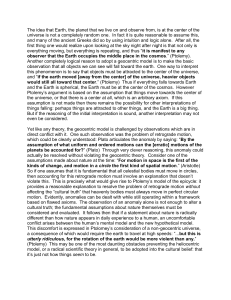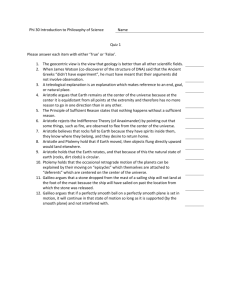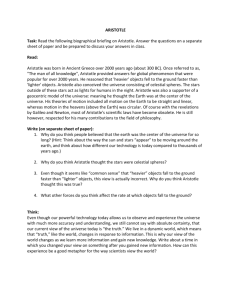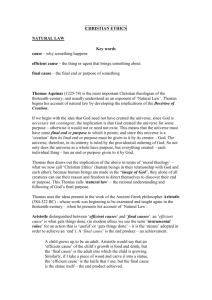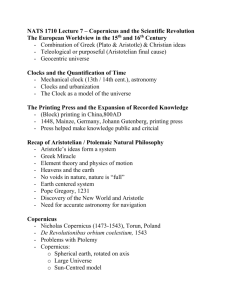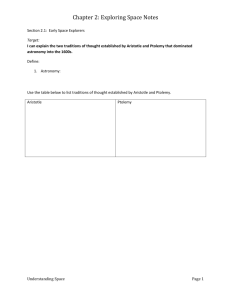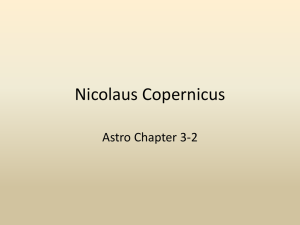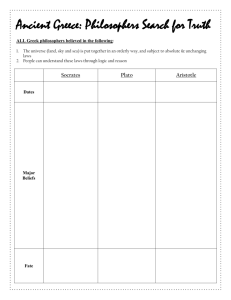Excerpts from The Scientific Revolution (1998)
advertisement
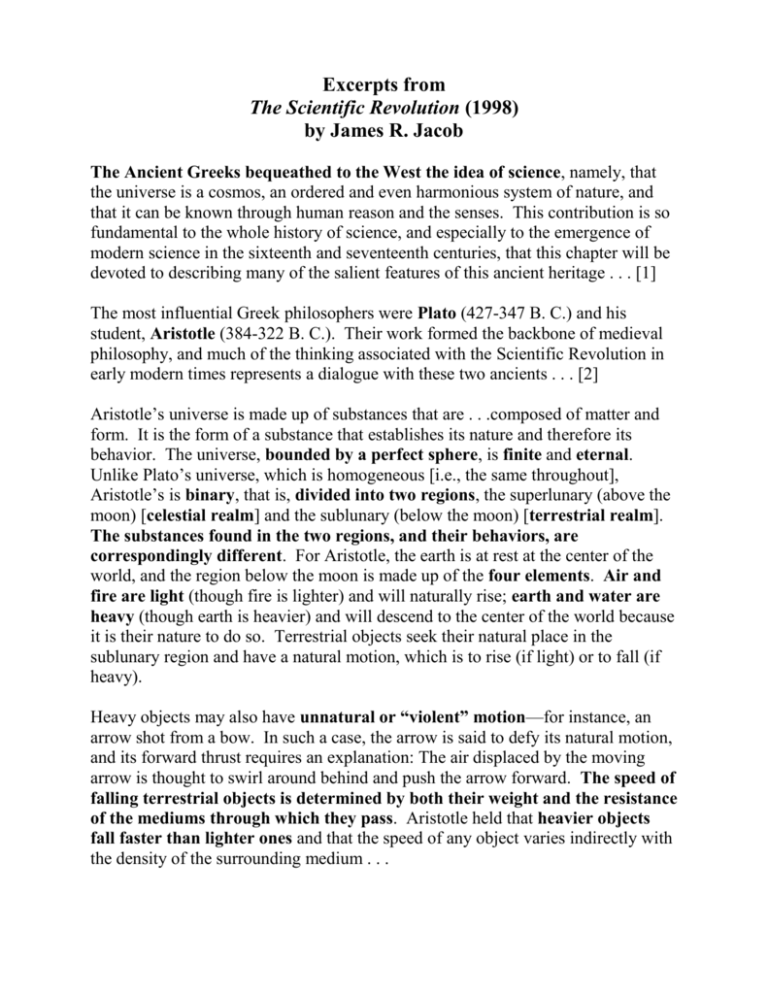
Excerpts from The Scientific Revolution (1998) by James R. Jacob The Ancient Greeks bequeathed to the West the idea of science, namely, that the universe is a cosmos, an ordered and even harmonious system of nature, and that it can be known through human reason and the senses. This contribution is so fundamental to the whole history of science, and especially to the emergence of modern science in the sixteenth and seventeenth centuries, that this chapter will be devoted to describing many of the salient features of this ancient heritage . . . [1] The most influential Greek philosophers were Plato (427-347 B. C.) and his student, Aristotle (384-322 B. C.). Their work formed the backbone of medieval philosophy, and much of the thinking associated with the Scientific Revolution in early modern times represents a dialogue with these two ancients . . . [2] Aristotle’s universe is made up of substances that are . . .composed of matter and form. It is the form of a substance that establishes its nature and therefore its behavior. The universe, bounded by a perfect sphere, is finite and eternal. Unlike Plato’s universe, which is homogeneous [i.e., the same throughout], Aristotle’s is binary, that is, divided into two regions, the superlunary (above the moon) [celestial realm] and the sublunary (below the moon) [terrestrial realm]. The substances found in the two regions, and their behaviors, are correspondingly different. For Aristotle, the earth is at rest at the center of the world, and the region below the moon is made up of the four elements. Air and fire are light (though fire is lighter) and will naturally rise; earth and water are heavy (though earth is heavier) and will descend to the center of the world because it is their nature to do so. Terrestrial objects seek their natural place in the sublunary region and have a natural motion, which is to rise (if light) or to fall (if heavy). Heavy objects may also have unnatural or “violent” motion—for instance, an arrow shot from a bow. In such a case, the arrow is said to defy its natural motion, and its forward thrust requires an explanation: The air displaced by the moving arrow is thought to swirl around behind and push the arrow forward. The speed of falling terrestrial objects is determined by both their weight and the resistance of the mediums through which they pass. Aristotle held that heavier objects fall faster than lighter ones and that the speed of any object varies indirectly with the density of the surrounding medium . . . For Aristotle, the terrestrial region is a setting for incessant change . . . But the heavens are altogether different. According to Aristotle, it is a matter of observation that the heavens never change. They must therefore be composed of an incorruptible fifth element, called ether, which fills the entire celestial region. Following the complex scheme worked out by Eudoxus of Cnidus (390ca. 337 B.C.), Aristotle held that the planets and stars are attached to perfect concentric spheres that revolve with the most perfect of movements, that is, eternally unvarying circular motion, around a stationary earth. The cause of this motion is the desire of the spheres to imitate the perfection of the Unmoved Mover . . . The heavens—concentric spheres, planets, and stars— are divine . . . The celestial bodies are moving divinities. “Beyond them, incorporeal and outside the universe, is the primary divinity, the changeless originator of all change,” the Unmoved Mover. Aristotle’s authority in cosmology was never absolute in the ancient world. But it was enough to overcome rival theories and to provide the foundation for further development in astronomical theory . . . [3-5] Following in the footsteps of earlier observers of the skies, Claudius Ptolemy (fl. 150 A. D.) summed up the development of astronomy in the ancient world by constructing the most elegant mathematical model of the motions of the planets. Ptolemy himself was a convinced Aristotelian and devoted himself to devising a model that, complex though it was, would uphold the requirement of uniform circular motion in the heavens. He committed himself, in other words, to “saving the phenomena,” that is, to preserving Aristotle’s binary universe of perfect heavens swinging forever around a stationary earth. He adopted three devices. From Appolonius of Perga (fl. 210 B. C.), he borrowed the twin models of the eccentric circle and the epicycle on a deferent . . . The third model of planetary motion, the equant, was Ptolemy’s own invention . . . Ptolemy’s purpose in deploying these three devices was to square the observed irregularity of planetary motion with the theoretical requirement of uniform circular motion. The Scientific Revolution would begin when Copernicus broke from Ptolemy’s picture of the universe, not because the fit he [Ptolemy] had established between theory and observations was not convincing at all and so his theory had to be discarded, but, paradoxically enough, because the fit was not perfect enough, and so his [Ptolemy’s] theory had to be adjusted. In particular, the offending equant point, which Copernicus thought a blemish on so noble a picture, had to be removed. The deep and lasting commitment to uniform, circular motion was to survive and even promote the first stages in the Scientific Revolution. Ptolemy’s achievement was remarkable and had multiple effects. It preserved the binary system of Aristotle’s universe. It enabled astronomers to make reliable predictions of future planetary positions, and, on that basis (and no less important to Ptolemy), is supposedly enabled astrologers to predict future events on earth. For Ptolemy . . . the mathematical study of the heavens also had an ethical dimension: “Astronomy teaches man to regulate his life in imitation of the order, constancy, and tranquillity of the celestial motions.” Finally, Ptolemy’s was the model that was handed down and accepted through the centuries as offering the true picture of the heavens, until it was eventually challenged and gradually undermined in the sixteenth and early seventeenth centuries, almost fifteen hundred years after it was put forward in Ptolemy’s great work, the Almagest (150 A. D.) . . . [6-10] [The] ancient tradition that turned out to be the most successful in the Middle Ages, and that remained vital up until the middle of the seventeenth century, was that of Aristotle and Ptolemy . . . Ptolemy’s Almagest and most of the works of Aristotle were available in Latin translation by 1200 and grew more influential in the next several decades . . . [14] Study Questions/Suggestions [Not to be handed in] 1) You should be able to explain the main components of Aristotle’s geocentric model (4th century B. C.). Practice by drawing a diagram, labeling the major parts, and explaining the model in writing. 2) You should also be able to explain Ptolemy’s major contributions (2nd century A. D.) to the Aristotelian model of the universe. Practice by drawing diagrams and being able to explain them in writing. Why was this model accepted for so long? 3) Finally, you should be able to explain why Copernicus’s heliocentric model (16th century A. D.), even though placing the sun at the center, was NOT a completely radical break from the ancient Greek Aristotelian-Ptolemaic model. Why did Copernicus do what he did? NOTE: It may help to study with others in the class. Also, it is your responsibility to ask questions and get help from the instructor when you do not understand this (or any other) material.
